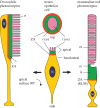Evolution of vertebrate retinal photoreception
- PMID: 19720653
- PMCID: PMC2781864
- DOI: 10.1098/rstb.2009.0102
Evolution of vertebrate retinal photoreception
Abstract
Recent findings shed light on the steps underlying the evolution of vertebrate photoreceptors and retina. Vertebrate ciliary photoreceptors are not as wholly distinct from invertebrate rhabdomeric photoreceptors as is sometimes thought. Recent information on the phylogenies of ciliary and rhabdomeric opsins has helped in constructing the likely routes followed during evolution. Clues to the factors that led the early vertebrate retina to become invaginated can be obtained by combining recent knowledge about the origin of the pathway for dark re-isomerization of retinoids with knowledge of the inability of ciliary opsins to undergo photoreversal, along with consideration of the constraints imposed under the very low light levels in the deep ocean. Investigation of the origin of cell classes in the vertebrate retina provides support for the notion that cones, rods and bipolar cells all originated from a primordial ciliary photoreceptor, whereas ganglion cells, amacrine cells and horizontal cells all originated from rhabdomeric photoreceptors. Knowledge of the molecular differences between cones and rods, together with knowledge of the scotopic signalling pathway, provides an understanding of the evolution of rods and of the rods' retinal circuitry. Accordingly, it has been possible to propose a plausible scenario for the sequence of evolutionary steps that led to the emergence of vertebrate photoreceptors and retina.
Figures



Similar articles
-
Evolution of phototransduction, vertebrate photoreceptors and retina.Prog Retin Eye Res. 2013 Sep;36:52-119. doi: 10.1016/j.preteyeres.2013.06.001. Epub 2013 Jun 19. Prog Retin Eye Res. 2013. PMID: 23792002 Review.
-
The evolution of early vertebrate photoreceptors.Philos Trans R Soc Lond B Biol Sci. 2009 Oct 12;364(1531):2925-40. doi: 10.1098/rstb.2009.0099. Philos Trans R Soc Lond B Biol Sci. 2009. PMID: 19720654 Free PMC article. Review.
-
Amphioxus photoreceptors - insights into the evolution of vertebrate opsins, vision and circadian rhythmicity.Int J Dev Biol. 2017;61(10-11-12):665-681. doi: 10.1387/ijdb.170230zk. Int J Dev Biol. 2017. PMID: 29319115 Review.
-
Ciliary photoreceptors in the cerebral eyes of a protostome larva.Evodevo. 2011 Mar 1;2:6. doi: 10.1186/2041-9139-2-6. Evodevo. 2011. PMID: 21362157 Free PMC article.
-
Loss and gain of cone types in vertebrate ciliary photoreceptor evolution.Dev Biol. 2017 Nov 1;431(1):26-35. doi: 10.1016/j.ydbio.2017.08.038. Epub 2017 Sep 4. Dev Biol. 2017. PMID: 28882401 Review.
Cited by
-
chaoptin, prominin, eyes shut and crumbs form a genetic network controlling the apical compartment of Drosophila photoreceptor cells.Biol Open. 2014 Apr 4;3(5):332-41. doi: 10.1242/bio.20147310. Biol Open. 2014. PMID: 24705015 Free PMC article.
-
Light and the laboratory mouse.J Neurosci Methods. 2018 Apr 15;300:26-36. doi: 10.1016/j.jneumeth.2017.04.007. Epub 2017 Apr 14. J Neurosci Methods. 2018. PMID: 28414048 Free PMC article.
-
The Zebrafish Retina and the Evolution of the Onecut-Mediated Pathway in Cell Type Differentiation.Cells. 2024 Dec 15;13(24):2071. doi: 10.3390/cells13242071. Cells. 2024. PMID: 39768162 Free PMC article.
-
Molecular Evidence for Convergence and Parallelism in Evolution of Complex Brains of Cephalopod Molluscs: Insights from Visual Systems.Integr Comp Biol. 2015 Dec;55(6):1070-83. doi: 10.1093/icb/icv049. Epub 2015 May 21. Integr Comp Biol. 2015. PMID: 26002349 Free PMC article.
-
Onecut Regulates Core Components of the Molecular Machinery for Neurotransmission in Photoreceptor Differentiation.Front Cell Dev Biol. 2021 Mar 18;9:602450. doi: 10.3389/fcell.2021.602450. eCollection 2021. Front Cell Dev Biol. 2021. PMID: 33816460 Free PMC article.
References
-
- Arendt D.2003Evolution of eyes and photoreceptor cell types. Int. J. Dev. Biol. 47, 563–571 - PubMed
-
- Arendt D.2008The evolution of cell types in animals: emerging principles from molecular studies. Nat. Rev. Genet. 9, 868–882 (doi:10.1038/nrg2416) - DOI - PubMed
-
- Arendt D., Wittbrodt J.2001Reconstructing the eyes of Urbilateria. Phil. Trans. R. Soc. Lond. B 356, 1545–1563 (doi:10.1098/rstb.2001.0971) - DOI - PMC - PubMed
-
- Arendt D., Tessmar-Raible K., Snyman H., Dorresteijn A. W., Wittbrodt J.2004Ciliary photoreceptors with a vertebrate-type opsin in an invertebrate brain. Science 306, 869–871 (doi:10.1126/science.1099955) - DOI - PubMed
-
- Arendt D., Hausen H., Purschke G.2009The ‘division of labour’ model of eye evolution. Phil. Trans. R. Soc. B 364, 2809–2817 (doi:10.1098/rstb.2009.0104) - DOI - PMC - PubMed
Publication types
MeSH terms
Substances
LinkOut - more resources
Full Text Sources

